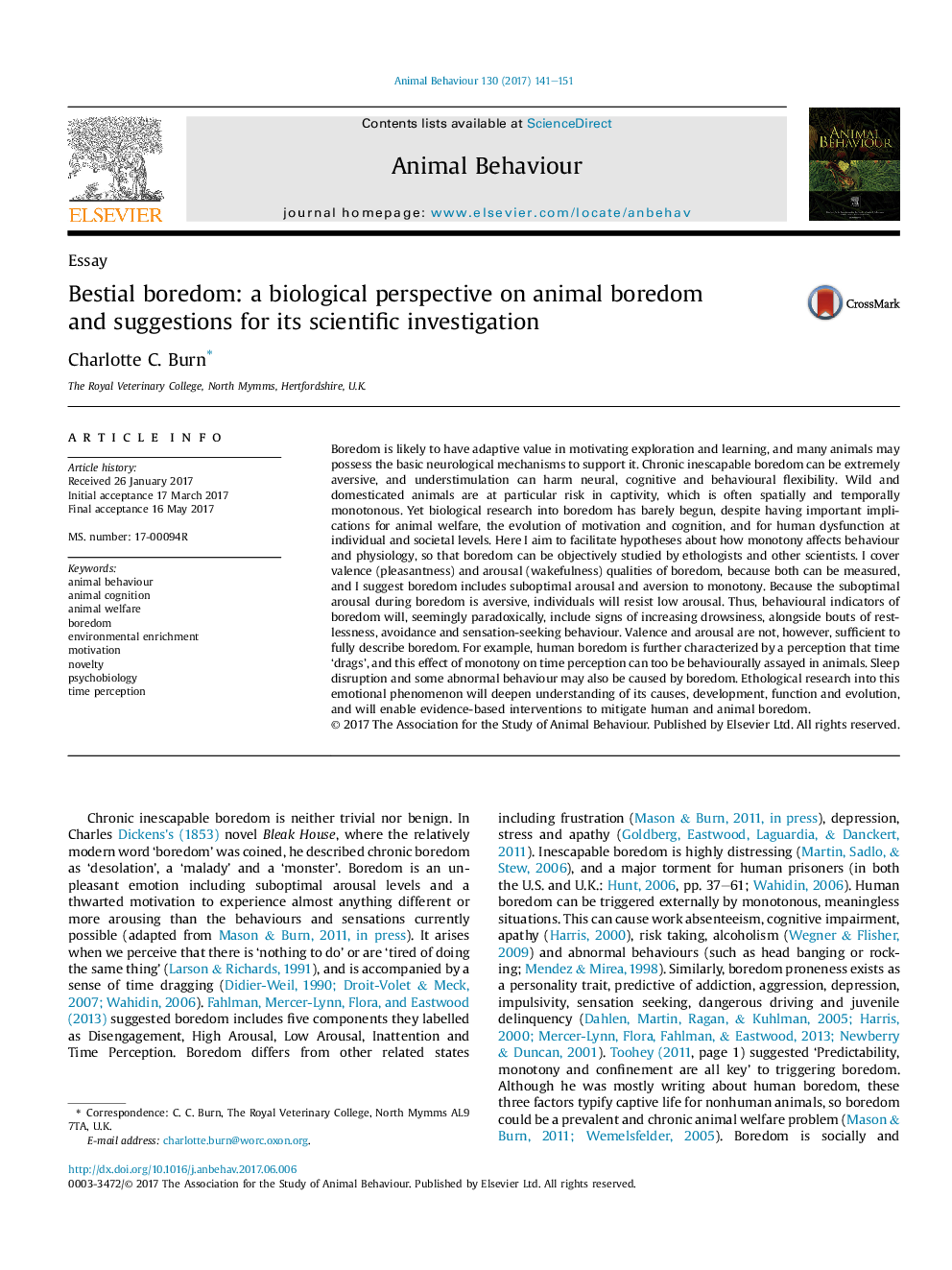| کد مقاله | کد نشریه | سال انتشار | مقاله انگلیسی | نسخه تمام متن |
|---|---|---|---|---|
| 5538399 | 1552198 | 2017 | 11 صفحه PDF | دانلود رایگان |
عنوان انگلیسی مقاله ISI
Bestial boredom: a biological perspective on animal boredom and suggestions for its scientific investigation
ترجمه فارسی عنوان
خستگی مفرط: یک دیدگاه بیولوژیکی در مورد خستگی حیوانات و پیشنهادات برای تحقیقات علمی آن
دانلود مقاله + سفارش ترجمه
دانلود مقاله ISI انگلیسی
رایگان برای ایرانیان
کلمات کلیدی
رفتار حیوانات، شناخت حیوانات، رفاه حیوانات، خستگی، غنی سازی محیطی، انگیزه، اخبار روانشناسی، ادراک زمان،
ترجمه چکیده
خستگی احتمالا دارای ارزش تطبیقی در انگیزه اکتشاف و یادگیری است و بسیاری از حیوانات ممکن است مکانیسم های عصبی پایه ای برای حمایت از آن داشته باشند. خستگی اجتناب ناپذیر مزمن می تواند بسیار ناخوشایند باشد و عدم تحرک می تواند انعطاف پذیری عصبی، شناختی و رفتاری را به خطر بیندازد. حیوانات وحشی و اهلی در معرض خطر خاصی در اسارت هستند، که اغلب فضایی و موقتی یکنواخت هستند. با این حال تحقیقات بیولوژیکی در مورد خستگی به سختی شروع به وجود آورد، به رغم اثرات مهم برای رفاه حیوانات، تکامل انگیزه و شناخت و اختلال عملکرد انسان در سطوح فردی و اجتماعی. در اینجا هدف من این است که فرضیه ها را در مورد اینکه چگونه یکنواختی بر رفتار و فیزیولوژی تاثیر می گذارد، تسهیل می شود تا خستگی بتواند توسط اخلاق شناسان و سایر دانشمندان مورد بررسی قرار گیرد. من احساسات و خستگی (خستگی) را از خستگی می پوشانم، زیرا هر دو می توانند اندازه گیری شوند، و من از خستگی می خواهم که باعث برانگیختگی های غیرمتعارف و نومیدی به یکنواختی می شود. از آنجا که تحریک سایپمتیمال در حین خستگی مفرط است، افراد در برابر تحریک کم مقاومت می کنند. به این ترتیب، شاخص های رفتاری خستگی، به ظاهر متناقض، شامل نشانه هایی از افزایش خواب آلودگی، همراه با بی قرار بودن، اجتناب و رفتارهای احساسی است. با این حال، احساس خستگی و خستگی کامل نیست. به عنوان مثال، خستگی انسانی بیشتر با ادراک زمانی که "کشش" مشخص می شود مشخص می شود و این اثر یکنواختی در ادراک زمان نیز می تواند در حیوانات مورد سنجش رفتار قرار گیرد. اختلال خواب و برخی رفتارهای غیر طبیعی نیز ممکن است ناشی از خستگی باشد. تحقیقات اخلاقی در این پدیده عاطفی، درک علل، توسعه، عملکرد و تکامل آن را عمیق تر خواهد کرد و مداخلات مبتنی بر شواهد را برای کاهش خستگی انسان و حیوان فراهم خواهد کرد.
موضوعات مرتبط
علوم زیستی و بیوفناوری
علوم کشاورزی و بیولوژیک
علوم دامی و جانورشناسی
چکیده انگلیسی
Boredom is likely to have adaptive value in motivating exploration and learning, and many animals may possess the basic neurological mechanisms to support it. Chronic inescapable boredom can be extremely aversive, and understimulation can harm neural, cognitive and behavioural flexibility. Wild and domesticated animals are at particular risk in captivity, which is often spatially and temporally monotonous. Yet biological research into boredom has barely begun, despite having important implications for animal welfare, the evolution of motivation and cognition, and for human dysfunction at individual and societal levels. Here I aim to facilitate hypotheses about how monotony affects behaviour and physiology, so that boredom can be objectively studied by ethologists and other scientists. I cover valence (pleasantness) and arousal (wakefulness) qualities of boredom, because both can be measured, and I suggest boredom includes suboptimal arousal and aversion to monotony. Because the suboptimal arousal during boredom is aversive, individuals will resist low arousal. Thus, behavioural indicators of boredom will, seemingly paradoxically, include signs of increasing drowsiness, alongside bouts of restlessness, avoidance and sensation-seeking behaviour. Valence and arousal are not, however, sufficient to fully describe boredom. For example, human boredom is further characterized by a perception that time 'drags', and this effect of monotony on time perception can too be behaviourally assayed in animals. Sleep disruption and some abnormal behaviour may also be caused by boredom. Ethological research into this emotional phenomenon will deepen understanding of its causes, development, function and evolution, and will enable evidence-based interventions to mitigate human and animal boredom.
ناشر
Database: Elsevier - ScienceDirect (ساینس دایرکت)
Journal: Animal Behaviour - Volume 130, August 2017, Pages 141-151
Journal: Animal Behaviour - Volume 130, August 2017, Pages 141-151
نویسندگان
Charlotte C. Burn,
